Overview
The term “monolithic application” describes a software design paradigm where all components are tightly integrated into a single codebase. This integration simplifies development and deployment, particularly for smaller projects. However, while this approach offers initial ease of use and efficiency, it can lead to substantial challenges in scalability and maintenance as the complexity of the application grows. Therefore, it is crucial to consider carefully when to adopt such a structure.
Are you prepared to navigate the complexities that may arise? Recognizing the balance between simplicity and potential future complications will empower you to make informed decisions in your software design journey.
Introduction
In the ever-evolving landscape of software development, the choice of architecture can significantly impact a project’s success. Monolithic architecture, characterized by its unified codebase, presents a straightforward approach that particularly appeals to startups and small applications aiming for rapid deployment and simplicity.
However, as applications expand and scale, the limitations of this architecture become increasingly evident, igniting a debate among developers and organizations. This article delves into the intricacies of monolithic architecture, exploring its advantages and disadvantages, as well as the circumstances under which it thrives.
With insights from industry experts and real-world case studies, readers will gain a comprehensive understanding of when to embrace monolithic design and how it compares to the increasingly popular microservices architecture.
As the digital landscape continues to shift, recognizing the nuances of these architectural choices is crucial for informed decision-making and long-term success.
Understanding Monolithic Architecture: Definition and Key Characteristics
The term ‘monolithic application’ describes a software design paradigm where a system is constructed as a single, cohesive unit. In this model, all components—including the user interface, business logic, and data access layers—are tightly integrated within one codebase. This self-contained characteristic enables large software systems to function autonomously, without dependence on external services, streamlining both development and deployment procedures.
Consequently, unified design is frequently preferred by smaller projects or new companies eager to quickly introduce products to the market. However, as projects grow, the benefits of unified design may diminish. Increased complexity can lead to significant challenges in maintenance and scalability, particularly as the codebase expands.
For instance, while Netflix has effectively transitioned to a microservices model, it initially operated on a unified framework, showcasing the evolution of software design as organizational requirements change. Notably, Netflix’s online platform is now segmented into over 700 microservices, underscoring the shift towards more modular structures.
In 2025, a significant portion of companies still employ a unified design, with adoption rates reflecting its continued relevance in specific contexts. The key characteristics of monolithic application systems include their ease in initial development and deployment, which can be especially advantageous for organizations with limited resources or those in the early phases of product development. Expert opinions suggest that if the size and scope of the target software warrant it, transitioning to a microservices architecture may be more suitable in the long run.
This perspective is reinforced by recent discussions emphasizing the importance of evaluating the initial investment against the potential benefits of microservices, particularly for larger applications. Case studies, such as that of Intel Technology Poland, illustrate the challenges organizations face when expanding agile practices, which can be exacerbated by rigid structures. Research indicates that while a gradual shift to more adaptable structures is feasible, it requires meticulous planning to avoid disrupting ongoing product delivery.
Particular obstacles included logistical issues and knowledge transfer challenges, highlighting the necessity for a strategic approach.
Overall, while unified structures remain a viable option for many enterprises, understanding their characteristics and potential drawbacks is essential for making informed decisions regarding software design and development. As Gustavo Estrada from BC Provincial Health Services Authority noted, Avato streamlines complex projects and delivers outcomes within desired timelines and budget constraints, emphasizing the importance of selecting the appropriate framework for effective integration and modernization initiatives.
Advantages of Monolithic Architecture: Why Some Businesses Prefer It
The advantages of monolithic architecture, often referred to as monolithic application meaning, can significantly benefit various businesses. One of the primary strengths of a monolithic application meaning lies in the simplicity of maintaining a single codebase, which streamlines both development and deployment processes. This unified approach illustrates the monolithic application meaning, allowing teams to operate more efficiently and reducing the time and resources required to manage multiple services.
Furthermore, in the context of monolithic application meaning, testing becomes more straightforward within a unified environment, as all components are integrated. This integration facilitates end-to-end testing without the complexities associated with inter-service communication, clarifying the monolithic application meaning and leading to quicker identification and resolution of issues.
For smaller systems or those with restricted functionality, the monolithic application meaning suggests that adopting a unified approach can result in decreased operational overhead and expenses. This renders it especially attractive for startups and small enterprises seeking to optimize their resources, particularly in terms of monolithic application meaning. The swift development cycle characteristic of large-scale software allows organizations to iterate rapidly and react efficiently to market needs, a vital element in today’s fast-paced commercial environment.
In 2025, the benefits of unified structures continue to be significant, particularly as organizations aim to align their technology with corporate goals. As emphasized in recent discussions, while microservices provide scalability—enabling companies to begin with limited resources and grow as required—the simple structure of a monolithic application meaning can offer a competitive advantage for firms that prioritize speed and simplicity. Mike Tria, Head of Platform at Atlassian, emphasizes this perspective, stating, “We aligned with one of Atlassian’s core values: Don’t #@!% the customer,” underscoring the importance of customer-centric technology decisions.
Case studies demonstrate the monolithic application meaning by illustrating how organizations have effectively utilized unified structures to achieve significant cost savings compared to microservices. For instance, Avato’s approach to integration shows how maximizing the potential of legacy systems can lead to operational enhancements and reduced costs. Avato is dedicated to simplifying complex integrations through its hybrid integration platform, effectively addressing the challenges posed by disparate systems.
As noted by Gustavo Estrada, Acting Provincial Director at BC Provincial Health Services Authority, “Auto enabled us to align the outcomes we wanted to achieve in the time frame and price point we were targeting.” This strengthens the idea that for specific situations, a unified approach can be the most effective strategy, especially when backed by Avato’s dedication to addressing complex challenges and improving business value, which aligns with the monolithic application meaning.
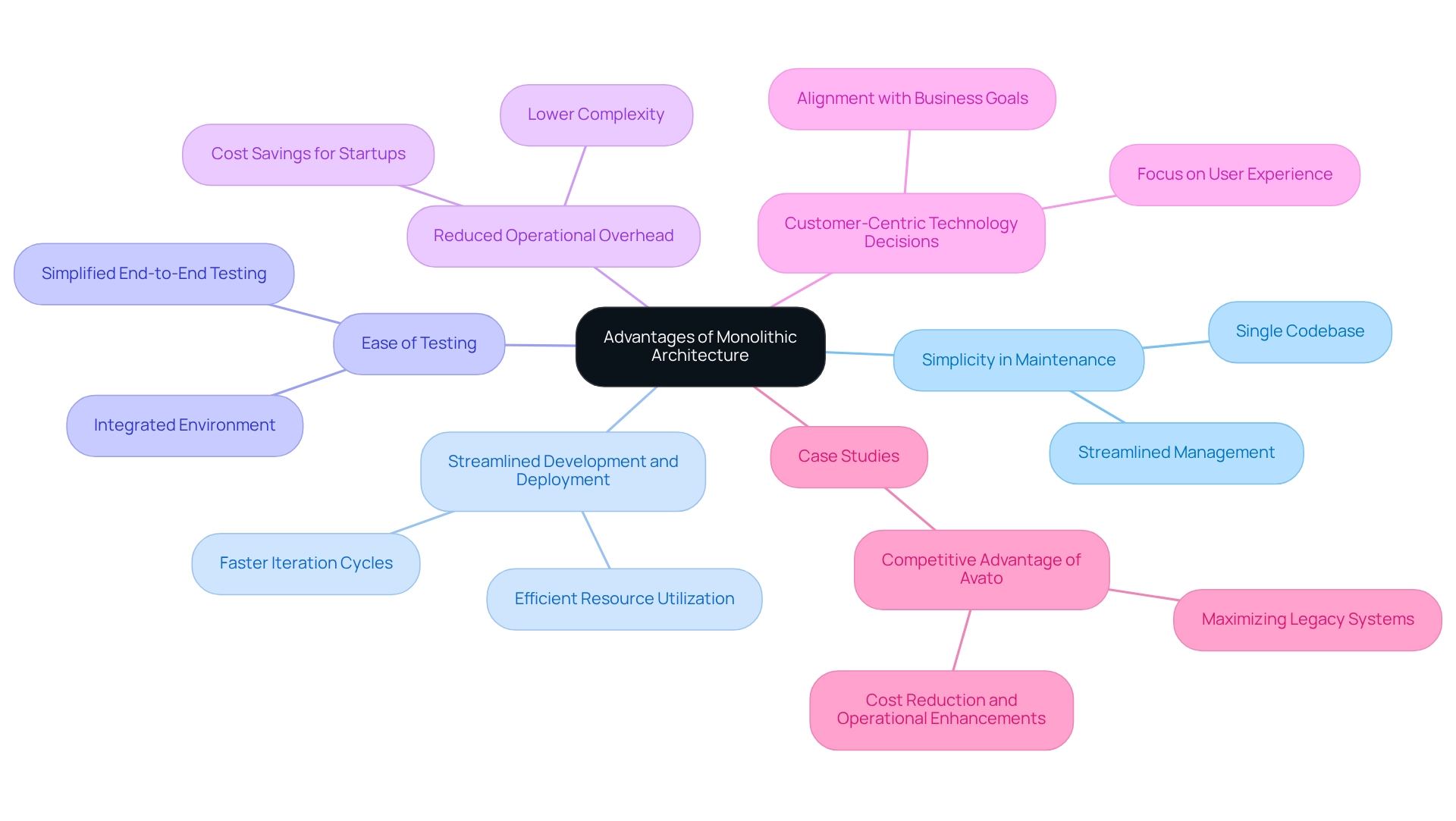
Disadvantages of Monolithic Architecture: Challenges and Limitations
While the concept of monolithic applications offers certain benefits, it is not without significant drawbacks. A primary concern is scalability; understanding the implications of monolithic applications is crucial, as managing and scaling these systems becomes increasingly challenging as they grow. In fact, over 60% of developers report challenges related to large-scale systems, particularly when implementing changes.
Changes to one part of the system in a monolithic application often necessitate redeploying the entire system, leading to possible downtime and an increased chance of mistakes. Furthermore, as large-scale systems evolve, they typically transition into monolithic architectures, which can create a substantial learning challenge for new developers attempting to navigate the codebase. This complexity complicates maintenance and stifles innovation, as the nature of monolithic applications indicates that integrating modern technologies into a tightly coupled system can be particularly arduous.
The lack of modularity in monolithic applications exacerbates these issues, often leading to vendor lock-in. Organizations may find themselves reliant on specific technologies or vendors, limiting their flexibility and adaptability in a rapidly changing technological landscape. Real-world case studies vividly illustrate these challenges. For instance, Avato’s effective execution of hybrid integration solutions in financial institutions demonstrates how organizations can surpass the constraints of unified systems.
A notable example is Avato’s collaboration with Coast Capital, where the integration facilitated major system transitions with minimal downtime, showcasing the speed and reliability of Avato’s solutions. Organizations attempting to scale large applications frequently encounter bottlenecks that obstruct their growth and responsiveness to market demands, underscoring the implications of monolithic applications. Expert insights suggest that shifting to more modular structures, such as microservices, can alleviate many of these issues, enabling businesses to innovate more freely and respond to changes with agility.
In this context, authentication and authorization mechanisms like OAuth 2.0 can enhance security in microservices frameworks, addressing some of the security challenges faced by unified systems. Avato’s approach to stakeholder engagement and process modeling ensures that organizations can effectively navigate these transitions. Customer testimonials highlight how Avato has simplified complex integration projects, with Gustavo Estrada noting its effectiveness in delivering results within desired time frames and budget constraints.
This underscores Avato’s ability to reduce expenses and improve operational functions, offering a feasible solution to the challenges posed by large-scale systems. Moreover, when selecting the appropriate infrastructure for microservices, considerations such as containerization, cloud platforms, cost assessment, and long-term scalability become essential, further emphasizing the drawbacks of traditional structures.
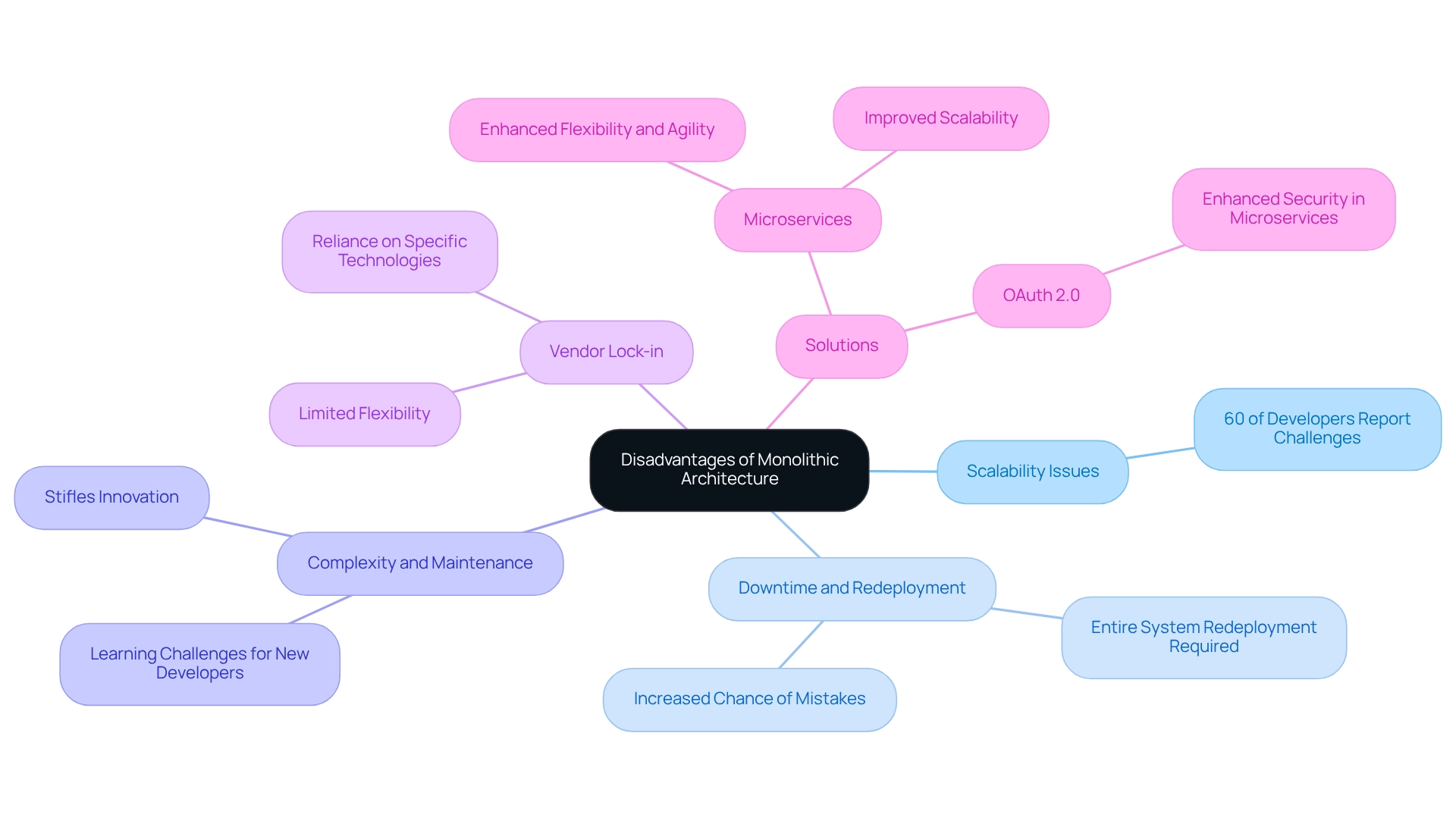
Monolithic vs. Microservices: A Comparative Analysis
In the comparison between monolithic design and microservices, several fundamental differences become apparent. The term ‘monolithic application’ describes software systems built as a single, cohesive entity, simplifying development and deployment. This approach is particularly advantageous for startups and basic projects due to its cost-effectiveness and ease of management.
Conversely, the microservices structure breaks down systems into smaller, independently deployable services. This modularity fosters enhanced flexibility and scalability, allowing organizations to update or scale individual services without impacting the entire system. However, the shift to microservices introduces complexities, particularly in inter-service communication and deployment strategies. Organizations must navigate the challenges of testing various components, potential security vulnerabilities associated with API gateways, and increased latency during scaling.
As of 2025, a substantial portion of companies have embraced microservices, indicating a rising trend towards this structure for intricate systems that demand agility and responsiveness.
Practical examples effectively demonstrate these dynamics. For instance, Atlassian’s transition to microservices resulted in faster deployment cycles, significantly improving reliability and performance. In contrast, cohesive design remains a viable option for enterprises with stable, well-defined requirements, where the simplicity of a unified system can outweigh the advantages of modularity.
Gustavo Estrada noted Avato’s ability to simplify complex projects and deliver results within desired time frames and budget constraints, highlighting the practical benefits of using Avato’s hybrid integration platform in this context. A comparative analysis reveals that while the monolithic application may suffice for certain scenarios, microservices are better suited for organizations anticipating rapid growth or frequent updates. The selection among these structures ultimately depends on the particular requirements and future goals of the organization, making it crucial for IT managers to assess their operational context thoughtfully. Furthermore, Avato’s hybrid integration platform provides a dependable, future-ready technology stack that can assist organizations in adapting to evolving requirements, tackling the intricacies of both systems.
This highlights the significance of choosing the appropriate structure and utilizing Avato’s commitment to designing technology foundations to improve business value. Overall, grasping the disadvantages of microservices, including testing challenges and possible security vulnerabilities, is vital for making informed choices in system design.
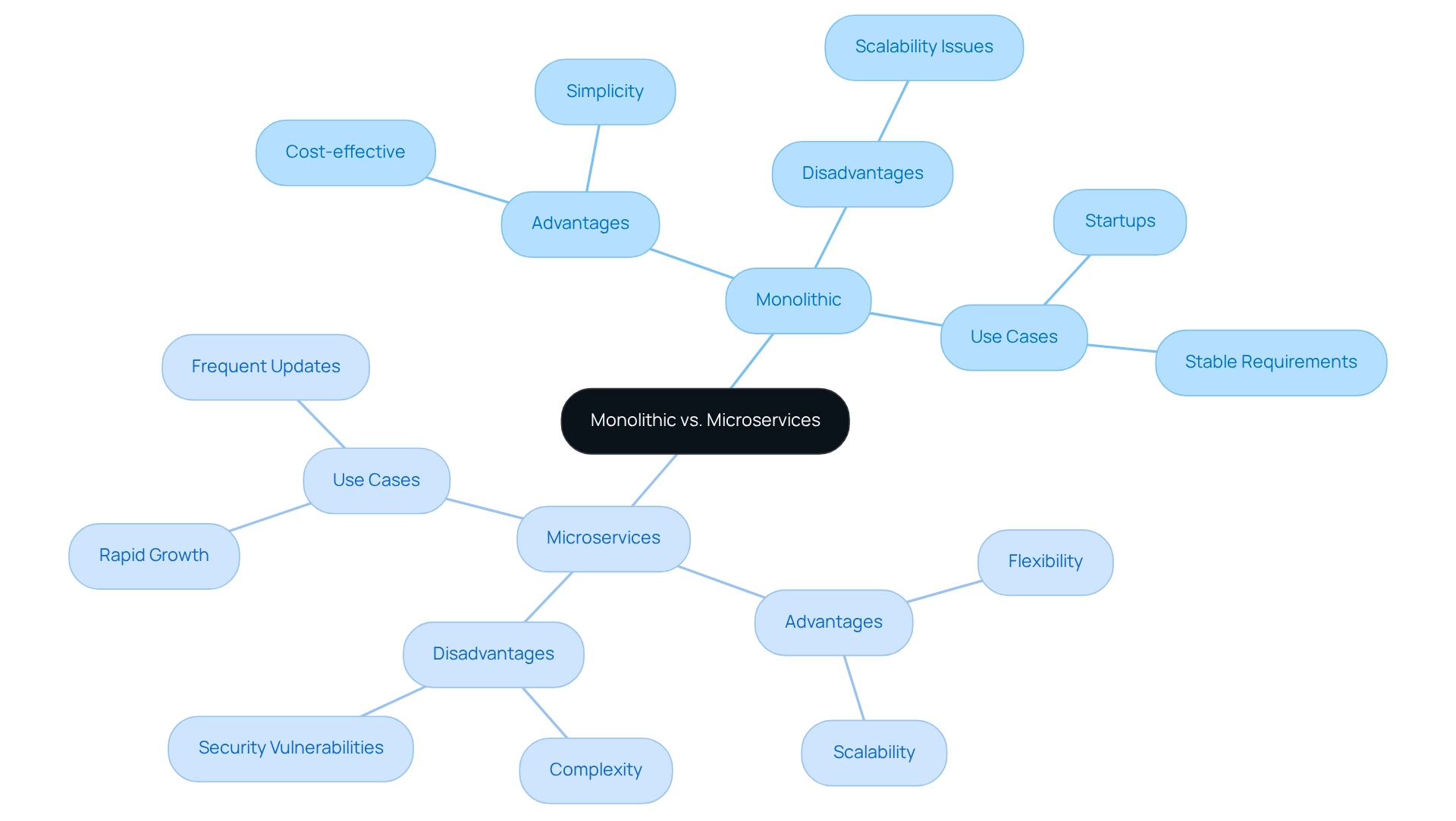
When to Use Monolithic Architecture: Ideal Scenarios and Applications
Monolithic design proves especially advantageous for small to medium-sized applications where requirements are stable and well-defined. Startups frequently adopt this approach when developing their Minimum Viable Products (MVPs), as it facilitates rapid development and reduces initial costs. Statistics indicate that approximately 70% of startups choose a unified structure for their MVPs, underscoring its appeal during the early stages of business development.
Applications that do not necessitate extensive scalability or complex integrations with other systems can significantly benefit from the simplicity inherent in a unified design. For instance, sectors such as e-commerce, where quick implementation and straightforward functionality are crucial, often regard a unified structure as an effective solution. Moreover, organizations with limited technical resources may prefer unified systems to avoid the complexities associated with microservices.
A notable case study exemplifying the effective application of unified structures is the Strangler Pattern for Migration. This strategy allows companies to gradually transition from a monolithic structure to microservices, enabling a controlled migration without disrupting existing services. By adopting this method, organizations can develop their framework while mitigating the risks associated with substantial changes.
This approach holds particular significance for companies evaluating their design choices, as it illustrates a practical pathway for modernization.
Gustavo Estrada, a client, remarked, “Avato has streamlined intricate projects and provided outcomes within expected timelines and financial limits,” highlighting the importance of selecting the appropriate framework to support organizational objectives. Avato’s hybrid integration platform is designed to assist organizations in assessing their current systems and crafting a comprehensive modernization plan that aligns with their strategic goals. This involves a thorough evaluation of existing systems and identifying areas that would benefit most from modernization, ensuring that the integration strategy is tailored to the specific needs of the organization.
Ultimately, while both architectures possess their strengths and weaknesses, understanding the meaning of monolithic applications is crucial for making informed decisions based on the particular requirements of the organization, including size, complexity, and growth stage. Avato’s reliable technology stack empowers companies to adapt to evolving demands, making it a vital consideration for organizations evaluating their integration solutions. Avato’s commitment to architecting technology foundations that enhance business value is evident in its approach to simplifying disparate systems and enabling seamless data connectivity.
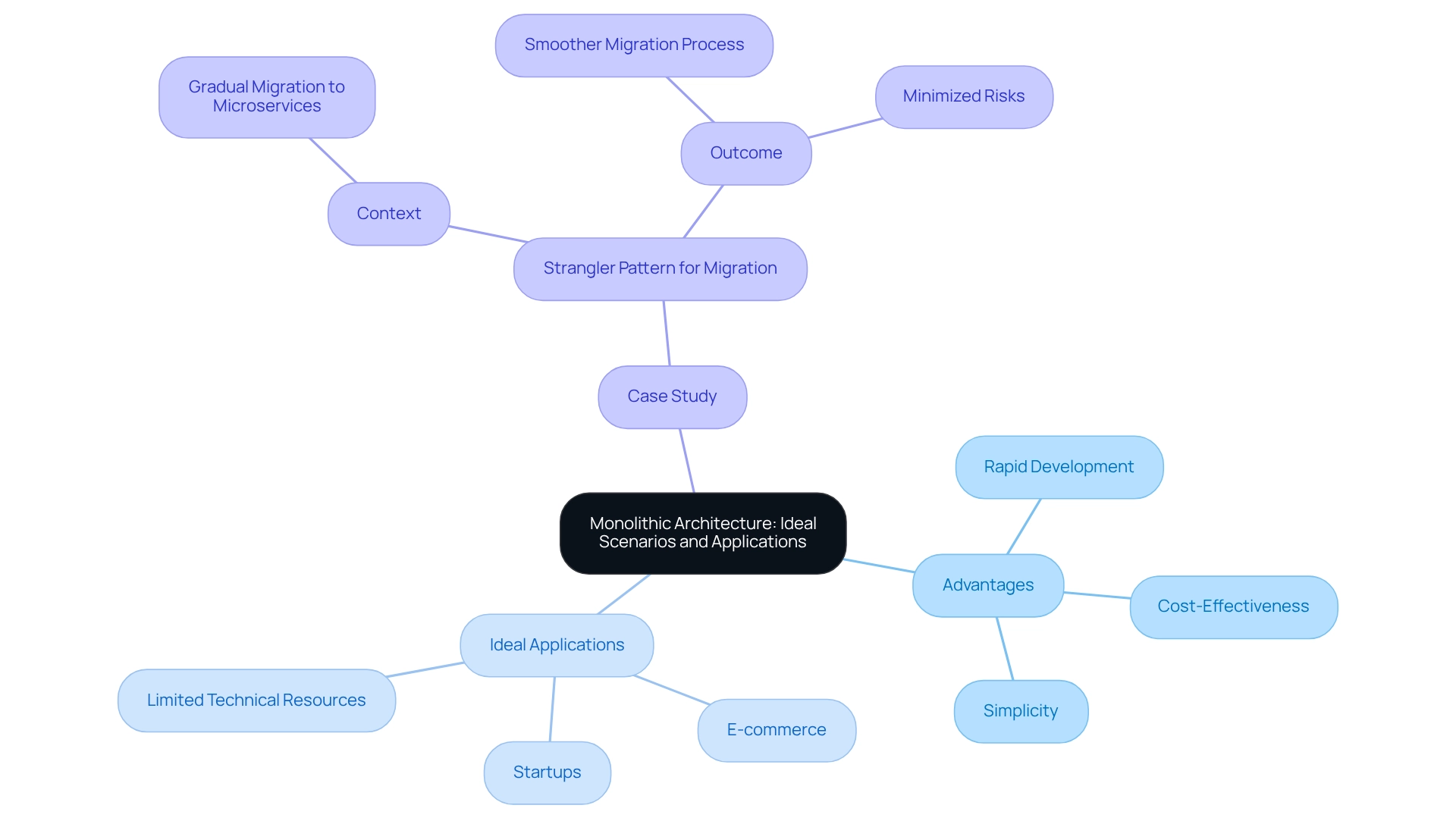
Best Practices for Monolithic Architecture: Ensuring Efficiency and Scalability
To ensure efficiency and scalability within monolithic applications, organizations must implement several best practices. A clean and organized codebase is paramount; employing modular design principles within the monolith allows for the separation of concerns, thereby enhancing maintainability. Frequent code evaluations are essential, as they not only assist in managing complexity but also enhance overall software performance.
As the software evolves, refactoring code becomes crucial to prevent the accumulation of technical debt. Incorporating automated testing and continuous integration/continuous deployment (CI/CD) practices can significantly streamline development processes, reducing the risk of errors during updates. Statistics indicate that microservices empower teams to push updates to individual services without affecting the entire system, underscoring the necessity of a robust framework that adapts to change.
This adaptability is further supported by Avato’s reliable hybrid integration platform, which enables businesses to maintain a competitive edge by seamlessly connecting legacy systems with modern technologies, thus responding effectively to shifting demands.
Monitoring system performance and gathering user feedback are vital components of preserving efficiency. This proactive approach allows teams to pinpoint bottlenecks and areas for improvement before they escalate into larger issues. Moreover, planning for future scalability by designing the architecture with potential growth in mind is critical. This foresight mitigates challenges associated with scaling, ensuring that the system remains responsive and effective as user demands increase.
Case studies, such as the systematic literature review on migrating to microservices, highlight the significance of quality attributes like performance, scalability, and maintainability in architectural decisions. These findings reveal a growing trend towards quality-focused migration strategies, emphasizing that the optimal architectural choice hinges on the application’s complexity, team size, and operational logic. Therefore, it is imperative for IT managers to evaluate all options meticulously before making an architectural decision.
By adhering to these best practices and leveraging Avato’s hybrid integration platform, organizations can sustain a competitive advantage while effectively managing their large-scale applications. Furthermore, Avato’s hybrid integration platform addresses the challenges posed by fragmented legacy systems, which often hinder innovation and operational efficiency. By integrating disparate systems, organizations can establish a more connected foundation that facilitates the deployment of new technologies, including AI and machine learning, with greater ease.
As digital transformation spending is projected to reach nearly $2 trillion annually by 2022, investing in a robust integration platform is not merely beneficial but essential for future-proofing business operations.
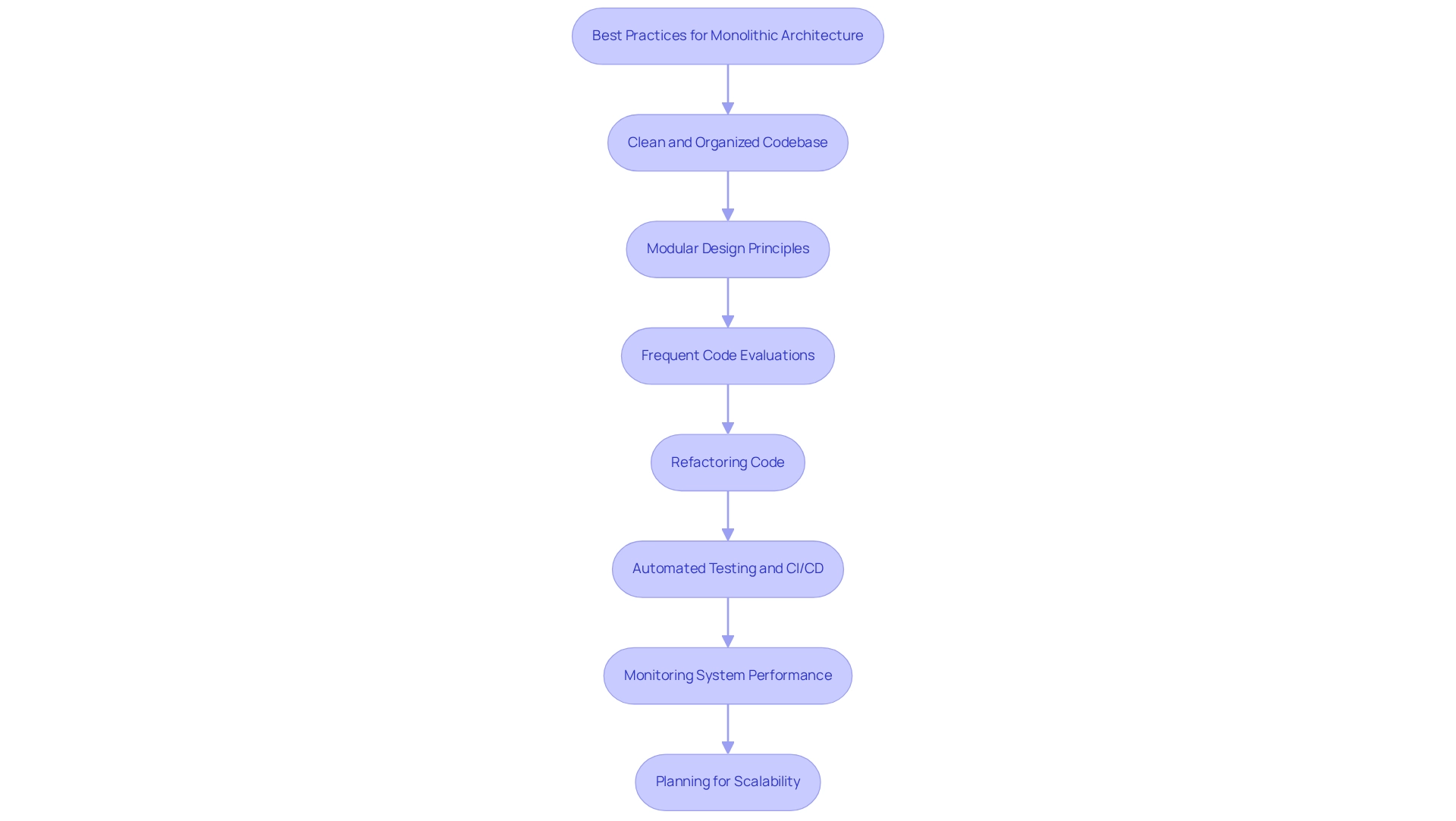
The Future of Monolithic Architecture: Trends and Innovations
As technology advances, unified architecture is evolving to meet new challenges and requirements. A significant trend is the rise of modular structures, which blend the simplicity of traditional unified systems with the advantages of modular design. This innovative approach not only enhances organization and maintainability but also preserves the benefits of a unified codebase.
Furthermore, advancements in containerization and orchestration technologies, such as Docker and Kubernetes, empower organizations to deploy software while grasping the implications of monolithic applications. This leads to greater flexibility and efficiency.
Looking ahead to 2025, it is anticipated that 90% of new applications will adopt cloud-native design, indicating a shift towards modernizing cloud infrastructures and moving away from legacy systems. This trend underscores the growing preference for modular monoliths, which provide a balanced solution for businesses eager for rapid innovation and agility. Expert insights suggest that the success of modular structures stems from their ability to enable scalability and define service boundaries, allowing organizations to respond swiftly to market demands.
As Rahul Sahay noted, “Their success wasn’t accidental — it was a direct result of betting on modular scalability and service boundaries early on.”
Moreover, the advantages of modular monoliths over conventional structures include reduced complexity and enhanced development speed, making them a compelling choice for businesses pursuing efficiency. For instance, statistics reveal that Starbucks’ Progressive Web App (PWA) is 99.84% smaller than the brand’s iOS mobile app, illustrating the efficiency and decreased complexity associated with modular approaches. As companies prioritize agility, the implications of monolithic applications suggest that these structures will likely coexist with microservices, offering practical solutions for scenarios where simplicity and speed are paramount.
Additionally, the trend of adopting cloud-native development is prompting businesses to modernize their cloud architecture, thereby enhancing efficiency and fostering innovation while distancing themselves from legacy systems. This shift reinforces the anticipated rise of modular monoliths. Cross-platform development tools like React Native and Flutter facilitate seamless app creation across devices, reducing costs and time, aligning perfectly with the discussion on modular monoliths.
Organizations should also consider leveraging Avato’s Hybrid Integration Platform for structured requirements management during their modernization efforts. This approach can enhance efficiency and support innovation, particularly when outsourcing software development to scale quickly, access specialized skills, or reduce time-to-delivery, especially for MVP builds or large migrations. Get your copy now.

Conclusion
Monolithic architecture continues to hold relevance in the software development landscape, particularly for startups and small applications that prioritize rapid deployment and simplicity. Its unified codebase presents significant advantages, including ease of maintenance, streamlined development, and reduced operational costs. Numerous case studies and expert opinions highlight these benefits, making monolithic architecture an appealing choice for businesses with stable requirements and limited resources, especially during the early stages of product development.
However, as applications grow and evolve, the limitations of monolithic architecture become increasingly evident. Challenges related to scalability, complexity, and the risk of vendor lock-in can stifle innovation and responsiveness in a rapidly changing technological environment. Real-world examples emphasize the necessity for businesses to carefully evaluate their architectural choices, considering a potential transition to more modular architectures like microservices as their needs evolve.
Ultimately, the decision between monolithic architecture and microservices should be driven by the specific requirements and future aspirations of the organization. By comprehensively understanding the strengths and weaknesses of each approach, IT managers can make informed decisions that align with their strategic objectives. As the technology landscape continues to evolve, embracing best practices and leveraging hybrid integration solutions will be crucial for businesses striving to maintain efficiency and adaptability in their software development journey.

